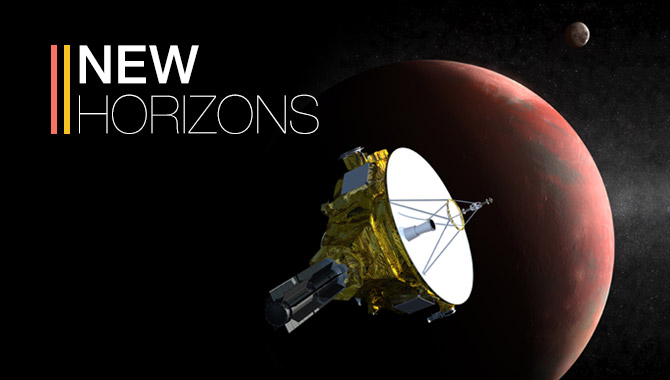New Horizons: a long way to the outskirts

After a series of news about the imminent (July 2015) convergence of the New Horizons automatic interplanetary station with Pluto, I wanted to put together all the information about the travel of the device over the past 8 years.
New Horizons was successfully launched on January 19, 2006 from Cape Canaveral by an Atlas V 551 rocket with a Centaur upper stage and headed for Jupiter to perform a gravitational maneuver.

')
It is worth noting that the speed of the AMS after the shutdown of third-stage engines was 46 km / s - this gave the New Horizons the status of the fastest device leaving the earth orbit. At the moment, the station speed is slightly less than 15 km / s, which loses to Voyager-1, which, due to maneuvers at Saturn, accelerated to 17 km / s.
In less than four months, New Horizons crossed the orbit of Mars (April 7, 2006), at a distance of 299 million km. from the red planet. The speed of the device at this time was 21 km / s.

The next mission point, Jupiter, was reached on February 28, 2007. To obtain the necessary acceleration, the AMC flew at a distance of 2.3 million km. (3 times closer than the passage of Cassini at one time) from Jupiter.

In addition to the maneuver, the station carried out more than 700 studies of the gas giant system. The speed before the gravitational maneuver is 23 km / s, after - 27 km / s.

Photo of Jupiter and Io (montage) by New Horizons
Saying goodbye to Jupiter, New Horizons was put into hibernation and went on a lonely 8-year journey to its goal - Pluto.
A year later (June 8, 2008), the AMC crossed the orbit of Saturn, while the planet itself was at a distance of 1.5 billion km. The speed by that time dropped to 18.26 km / s.
The orbit of Uranus (distance to it - 1.8 billion km.) The apparatus crossed March 18, 2011 at a speed of 15.75 km / s.
Now, on August 25, 2014, we are waiting for the intersection of the orbit of the last planet of the solar system - Neptune. Surprisingly, exactly 25 years ago, at the same time, Voyager-2 transmitted the first pictures of this planet and made many discoveries.
Now the station is at a distance of 28.47 AU. from the Sun and moves away from it at a speed of 14.81 km / s. Daily tracking of the “location” can be found on the NASA website .

Already 10 weeks before the next approach (July 14, 2015), NASA promises to show the first images of Pluto. Because of the high speed, New Horizons will stay near the planet for less than 3 hours (closer to Charon, Pluto's satellite, will occur within 14 minutes, after reaching the closest orbit point of Pluto), but the data transfer will end only after 9 weeks, since "Apload" to Earth will be less than 800 bits / s. The distance from the surface of Pluto will be 9600 km (the camera resolution will allow to observe objects on the surface of up to 60 m in size), Charon - 27 thousand km. An hour later, when the device goes to the dark side of the planet, it will begin to explore the atmosphere and try to find the ring.

After completing the mission, New Horizons will go to explore the Kuiper Belt objects, but which are still unknown, scientists hope to meet an object with a diameter of 100-150 km. The station will still be able to make a color map of the object, analyze it for the presence of the atmosphere, satellites and rings.
It remains only to wish good luck to our traveler and wait for the discovery of a new, unknown world.
Source: https://habr.com/ru/post/211703/
All Articles